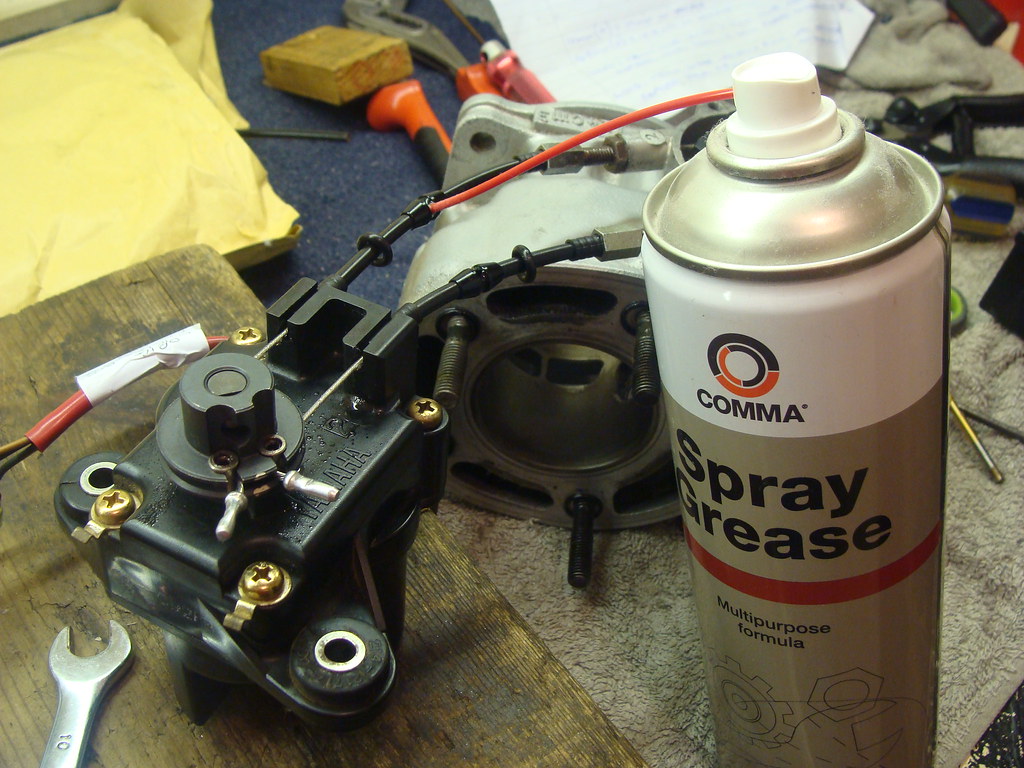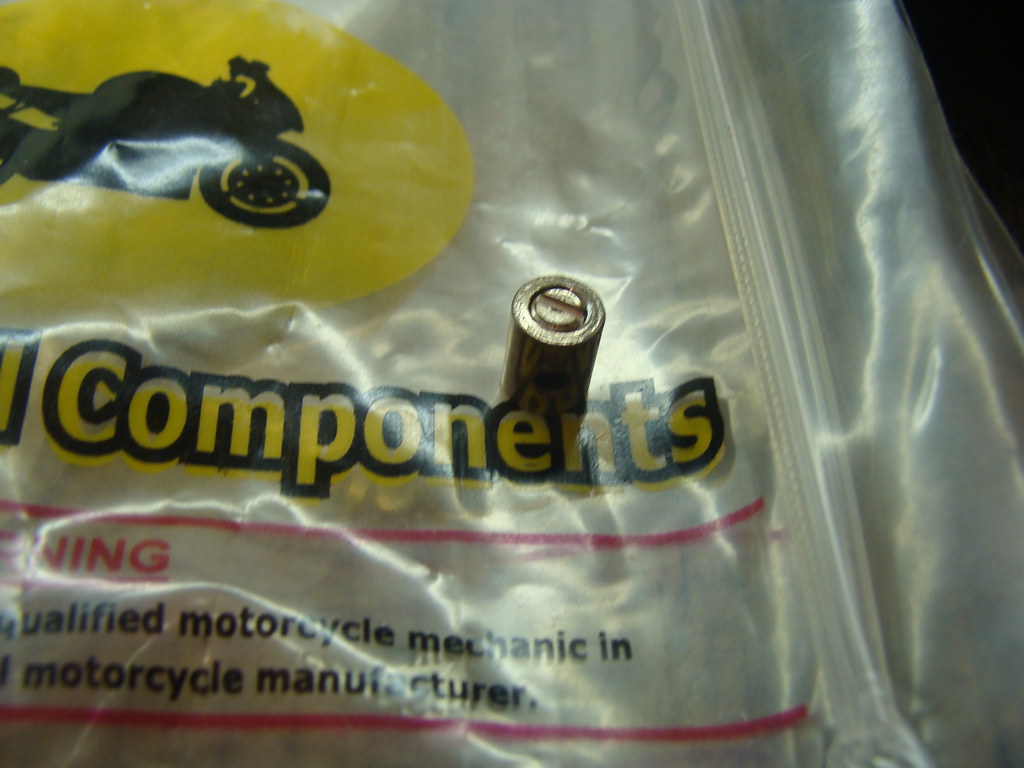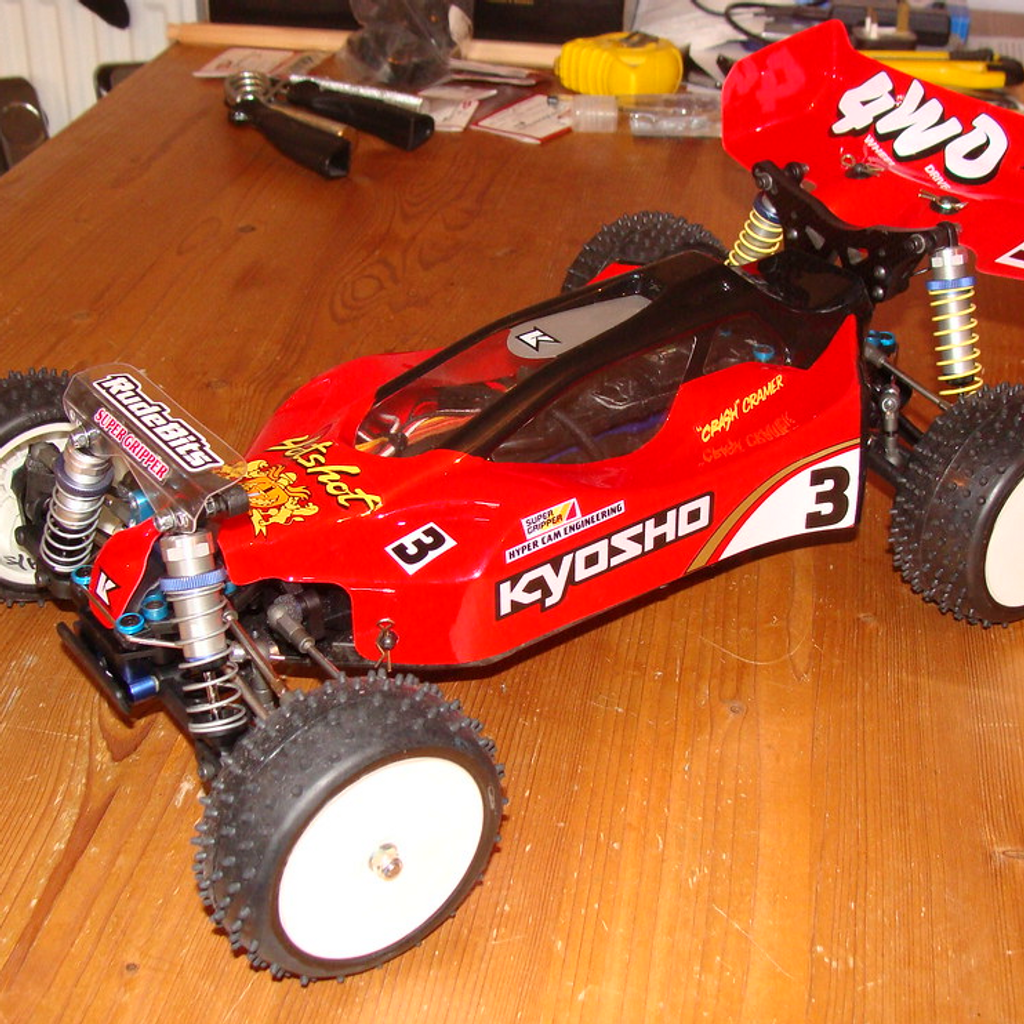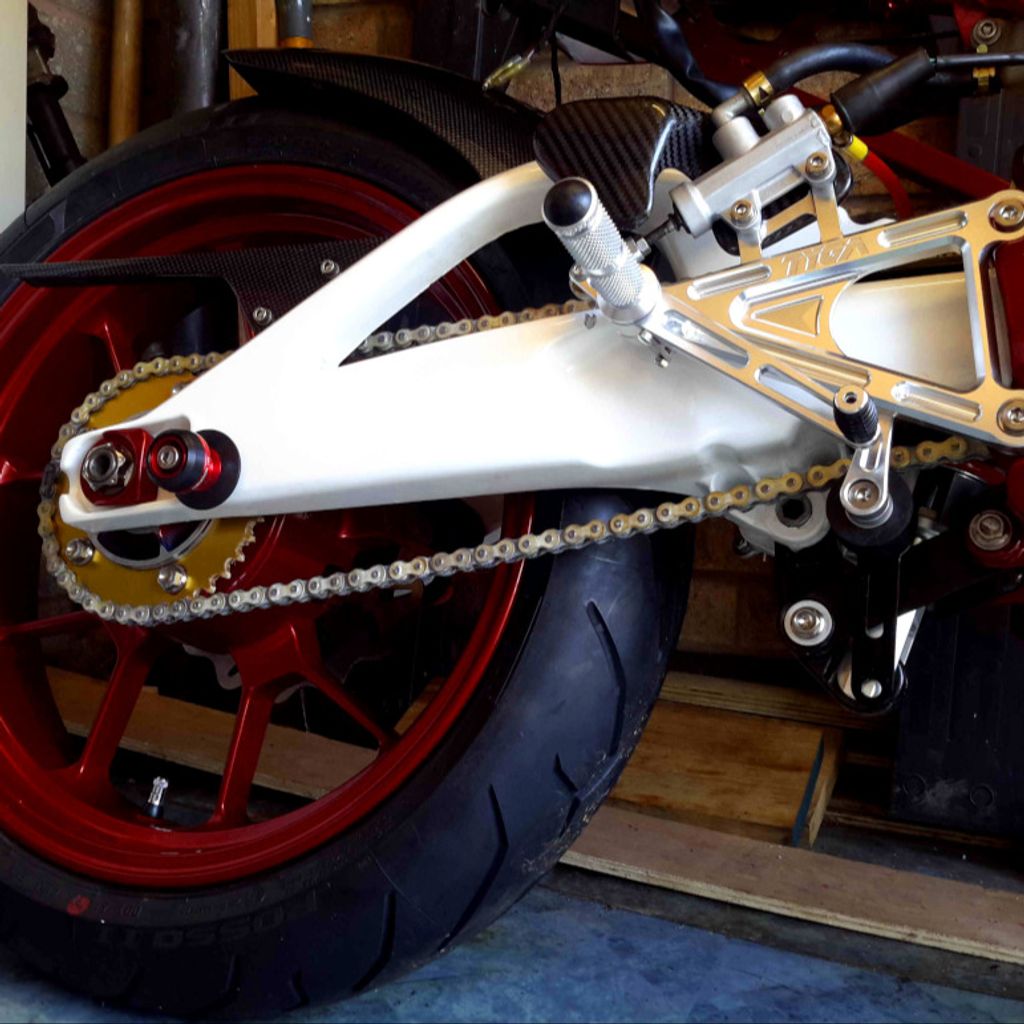Home Made Quick-Lube YPVS Powervalve Cables
-
A lot of running problems on DTRs are caused by sticky powervalve cables due to water and dirt ingress. As well as affecting your enjoyment of the bike, this puts a greater load on the servo which as we all know are becoming difficult to get hold of (particularly 3-wire versions). A genuine set costs £40; pattern ones are half the price but all the ones I've tried are the wrong legth meaning only a few adjuster threads engage in the pulley housing when they're adjusted correctly. However, it's possible to upgrade the cables so they're stronger than stock and you can clean and oil them externally in seconds. You'll need:
Mountain bike inner and 4mm outer gear cables (stainless steel inners are tougher than galvanised and the nipple is the same size as the one that fits into the pulley on the barrel)
Mountain bike 4mm inline cable oilers
6mm solderless nipples for the servo end
Some old powervalve cables as you need to save the threaded adjusters for re-use
Cable cutters (the type used by cycle shops)The first thing to do is remove the original/existing powervalve cables from the bike completely; don't worry about adjustment at this point because this will be done when the new cables are fitted. Next, turn on the ignition so the servo performs its cleaning cycle, turn off the ignition and disconnect the battery. This won't be reconnected until the new cables are fitted and adjusted.
Take the old cables and do whatever is necessary to remove the inner and outer cable from the adjuster; this usually means chopping the inner cables and carefully hacksawing the very top of the adjusters (the crimped portion above the 8mm hex) to free the outer cable from the adjuster. Then put the adjusters in a vice (using soft jaws to protect the threads) and carefully file or Dremel the top to tidy it up so the new outer cables fit into them easily. Also give them a good clean up so they screw into the pulley housing smoothly and make sure they're not bent as this is a right PITA when setting up the PV.
Screw the adjusters into the pulley housing and leave about 11mm of the threads exposed above the locknuts. This is so you can disconnect the outer cables from the servo later (to give you enough room to take the inner cables out of the pulley) if you need to.
Make up the outer cables the right length. Remember to factor in the length of the inline oilers and the little ferrules that fit onto each end (these are supplied with the outer cable and are a pretty snug fit into the servo's cable stops and the modified adjusters). Also the outer cables are a very tight fit into the inline oilers (they have to be so the lube goes where it should) so be ready for this.
Set the PV to the fully open position by putting a 4mm drill bit through the U-shaped part at the top of the pulley and locating it in the hole in the barrel behind it. Removing the exhaust and visually checking the actual valve is flush with the exhaust port roof is also useful here. You're now ready to install the inner cables.
Fit the inner cables starting at the pulley end and threading each one through the 2 lengths of outer cable and the inline oiler. The 6mm solderless nipples will need to be sat in the servo pulley ready so you can thread them through those as well. They're quite long so most of it will end up being cut off but don't worry, most cycle shops supply a pack of clamp-on cable ends to prevent fraying (these are fitted very last thing).
Pull the inner cables tight with pliers when tightening the grub screw in the solderless nipple; remember if the inner cables need to be disconnected from the pulley you've already provided 11mm of adjustment for this purpose (10mm is about how far the outer cable fits in the cable stops on the servo).
Cut off the excess cable and fit the cable ends (get them as short as possible to avoid fouling the rubber servo cover), and then adjust the PV cables according to the Yamaha/Haynes manual (fully tighten the inner cables and then back each adjuster off half a turn IIRC). Then fill those cables with lube! Watching clean spray grease come out of each end is strangely pleasurable.
Remove the 4mm drill but from the pulley BEFORE RECONNECTING THE BATTERY AND SWITCHING ON THE IGNITION; failing to do this can destroy the servo instantly.
Once you've made sure the cables are adjusted properly and the 4mm drill bit is removed from the pulley/housing, reconnect the battery and switch on the ignition. The servo at this point should perform one complete cycle and rest with the valve in the fully open position (it adjusts to engine speed when the engine starts). If you've done everything right you still might need to do a final adjustment to get it perfect just like if you've fitted new genuine cables.
This is a fiddly job which a lot of people CBA with, but the problem with YPVS is on most bikes the cables are too short and vertical to retain lube for any length of time. Plus a lot of people never lube them because this means readjusting them. This doesn't stop them acquiring grit and water however, and it is this which is responsible for most DTR powervalves ending up poorly adjusted and not working very well. Fit these properly and you'll have a set of PV cables stronger than stock which take about 30 seconds to clean/lube every time you wash the bike, all for about the same cost as buying a new genuine set.
I love inline cable oilers. I started using them on my mountain bike a few years ago, and they made the drivetrain so reliable I eventually forgot how to set up gears! Yes, I actually forgot and had to sit through the GMBN Tech how-to guide on YouTube. Most embarrasing 😠
https://www.sjscycles.co.uk/cables/jtek-cable-oilers-4mm-black-3-pack/



-
A lot of running problems on DTRs are caused by sticky powervalve cables due to water and dirt ingress. As well as affecting your enjoyment of the bike, this puts a greater load on the servo which as we all know are becoming difficult to get hold of (particularly 3-wire versions). A genuine set costs £40; pattern ones are half the price but all the ones I've tried are the wrong legth meaning only a few adjuster threads engage in the pulley housing when they're adjusted correctly. However, it's possible to upgrade the cables so they're stronger than stock and you can clean and oil them externally in seconds. You'll need:
Mountain bike inner and 4mm outer gear cables (stainless steel inners are tougher than galvanised and the nipple is the same size as the one that fits into the pulley on the barrel)
Mountain bike 4mm inline cable oilers
6mm solderless nipples for the servo end
Some old powervalve cables as you need to save the threaded adjusters for re-use
Cable cutters (the type used by cycle shops)The first thing to do is remove the original/existing powervalve cables from the bike completely; don't worry about adjustment at this point because this will be done when the new cables are fitted. Next, turn on the ignition so the servo performs its cleaning cycle, turn off the ignition and disconnect the battery. This won't be reconnected until the new cables are fitted and adjusted.
Take the old cables and do whatever is necessary to remove the inner and outer cable from the adjuster; this usually means chopping the inner cables and carefully hacksawing the very top of the adjusters (the crimped portion above the 8mm hex) to free the outer cable from the adjuster. Then put the adjusters in a vice (using soft jaws to protect the threads) and carefully file or Dremel the top to tidy it up so the new outer cables fit into them easily. Also give them a good clean up so they screw into the pulley housing smoothly and make sure they're not bent as this is a right PITA when setting up the PV.
Screw the adjusters into the pulley housing and leave about 11mm of the threads exposed above the locknuts. This is so you can disconnect the outer cables from the servo later (to give you enough room to take the inner cables out of the pulley) if you need to.
Make up the outer cables the right length. Remember to factor in the length of the inline oilers and the little ferrules that fit onto each end (these are supplied with the outer cable and are a pretty snug fit into the servo's cable stops and the modified adjusters). Also the outer cables are a very tight fit into the inline oilers (they have to be so the lube goes where it should) so be ready for this.
Set the PV to the fully open position by putting a 4mm drill bit through the U-shaped part at the top of the pulley and locating it in the hole in the barrel behind it. Removing the exhaust and visually checking the actual valve is flush with the exhaust port roof is also useful here. You're now ready to install the inner cables.
Fit the inner cables starting at the pulley end and threading each one through the 2 lengths of outer cable and the inline oiler. The 6mm solderless nipples will need to be sat in the servo pulley ready so you can thread them through those as well. They're quite long so most of it will end up being cut off but don't worry, most cycle shops supply a pack of clamp-on cable ends to prevent fraying (these are fitted very last thing).
Pull the inner cables tight with pliers when tightening the grub screw in the solderless nipple; remember if the inner cables need to be disconnected from the pulley you've already provided 11mm of adjustment for this purpose (10mm is about how far the outer cable fits in the cable stops on the servo).
Cut off the excess cable and fit the cable ends (get them as short as possible to avoid fouling the rubber servo cover), and then adjust the PV cables according to the Yamaha/Haynes manual (fully tighten the inner cables and then back each adjuster off half a turn IIRC). Then fill those cables with lube! Watching clean spray grease come out of each end is strangely pleasurable.
Remove the 4mm drill but from the pulley BEFORE RECONNECTING THE BATTERY AND SWITCHING ON THE IGNITION; failing to do this can destroy the servo instantly.
Once you've made sure the cables are adjusted properly and the 4mm drill bit is removed from the pulley/housing, reconnect the battery and switch on the ignition. The servo at this point should perform one complete cycle and rest with the valve in the fully open position (it adjusts to engine speed when the engine starts). If you've done everything right you still might need to do a final adjustment to get it perfect just like if you've fitted new genuine cables.
This is a fiddly job which a lot of people CBA with, but the problem with YPVS is on most bikes the cables are too short and vertical to retain lube for any length of time. Plus a lot of people never lube them because this means readjusting them. This doesn't stop them acquiring grit and water however, and it is this which is responsible for most DTR powervalves ending up poorly adjusted and not working very well. Fit these properly and you'll have a set of PV cables stronger than stock which take about 30 seconds to clean/lube every time you wash the bike, all for about the same cost as buying a new genuine set.
I love inline cable oilers. I started using them on my mountain bike a few years ago, and they made the drivetrain so reliable I eventually forgot how to set up gears! Yes, I actually forgot and had to sit through the GMBN Tech how-to guide on YouTube. Most embarrasing 😠
https://www.sjscycles.co.uk/cables/jtek-cable-oilers-4mm-black-3-pack/



Sweet! I’ve never seen those inline oilers before! Getting the length of the cables right is so important to the free movement of the motor & pulley. Seriously good thinking, bud!...
Kudos & thank you!... -
Sweet! I’ve never seen those inline oilers before! Getting the length of the cables right is so important to the free movement of the motor & pulley. Seriously good thinking, bud!...
Kudos & thank you!...@SpookDog Thanks man :+1:
When I got my 1st DTR in 1992 we still had the 12bhp learner restriction in the UK so the bikes were supplied without PV servos fitted and the valve was pegged in the closed position. Like a lot of people at the time I ran the valve pegged open, a 10 minute job which restored the top-end power at the expense of low-end performance which was about the same as a DT50MX. It made the bike very difficult to ride off-road and as the servo kit was so expensive from Yamaha, most full licence holders just sold on their TZR/DTR and bought a bigger bike. Probably also responsible for encouraging a whole generation of teenagers to ride it like they stole it as you had to absolutely rag the proverbial out of it to make it do pretty much anything.
I also worked in a Yamaha dealership at this time and when servicing and PDIing restricted DTRs I was impressed by the low-end torque although they went flat at about 6000rpm and did about 55mph flat out as you can imagine :-1:
Then in 2020 I bought my '93 French import and the (3-wire) servo did its cleaning cycle but didn't respond to engine speed which had both me and the seller scratching our heads. A used servo cured it meaning it's possible to fry the part of the PCB inside the 3-wire servo which responds to engine speed although I'm not sure how the previous owner managed this.
So after nearly 30 years of banging my head against a wall, I was finally able to enjoy a DT125R with fully functioning YPVS system as Yamaha intended. And I realised that despite owning a lot of bigger bikes in the meantime like several TDR250s, an RD500LC and a few 90s grey import 400s, that was what I wanted the most! I mean if I'd been a teenager in France or Italy I could have had that but a bunch of killjoys in the UK made it impossible. It's very pleasant to ride around town/green lanes sensibly and have walkers and horse riders wave to you knowing you've got plenty of power if you need it. So I've learned to love my powervalve cables :angel:
-
@SpookDog Thanks man :+1:
When I got my 1st DTR in 1992 we still had the 12bhp learner restriction in the UK so the bikes were supplied without PV servos fitted and the valve was pegged in the closed position. Like a lot of people at the time I ran the valve pegged open, a 10 minute job which restored the top-end power at the expense of low-end performance which was about the same as a DT50MX. It made the bike very difficult to ride off-road and as the servo kit was so expensive from Yamaha, most full licence holders just sold on their TZR/DTR and bought a bigger bike. Probably also responsible for encouraging a whole generation of teenagers to ride it like they stole it as you had to absolutely rag the proverbial out of it to make it do pretty much anything.
I also worked in a Yamaha dealership at this time and when servicing and PDIing restricted DTRs I was impressed by the low-end torque although they went flat at about 6000rpm and did about 55mph flat out as you can imagine :-1:
Then in 2020 I bought my '93 French import and the (3-wire) servo did its cleaning cycle but didn't respond to engine speed which had both me and the seller scratching our heads. A used servo cured it meaning it's possible to fry the part of the PCB inside the 3-wire servo which responds to engine speed although I'm not sure how the previous owner managed this.
So after nearly 30 years of banging my head against a wall, I was finally able to enjoy a DT125R with fully functioning YPVS system as Yamaha intended. And I realised that despite owning a lot of bigger bikes in the meantime like several TDR250s, an RD500LC and a few 90s grey import 400s, that was what I wanted the most! I mean if I'd been a teenager in France or Italy I could have had that but a bunch of killjoys in the UK made it impossible. It's very pleasant to ride around town/green lanes sensibly and have walkers and horse riders wave to you knowing you've got plenty of power if you need it. So I've learned to love my powervalve cables :angel:
Same as. It took me a while to suss out how to set up the 3 wire servo, with back to front cables and all, but I’d never be without that low rev torque again! My bike only revs up to about 10k though, I’m hoping it’s the exhaust (big1) causing this?...
-
Both cables have the same size?? Any One knows the lenght of the cables? I have 1 snapped and Im planing to make One with a steel cable from a bike's braking system
-
Both cables have the same size?? Any One knows the lenght of the cables? I have 1 snapped and Im planing to make One with a steel cable from a bike's braking system
@Hybrid_Theory01 Both cables have the same size nipples yes, 6mm barrel on the servo end and 4mm on the pulley (same as an MTB gear cable as described in the OP).
https://accessories.hitchcocksmotorcycles.com/accessory-shop/Solderless-Barrel-Nipples/11756
https://www.tredz.co.uk/.Clarks-Stainless-Steel-MTB-Hybrid-Road-Gear-Inner-Wire_129181.htm
TBH I don't know the precise length of the outer cables, because they're so short I just made up outer cables the right length with the servo installed on the bike. Inner and outer gear cable is pretty cheap from cycle shops (outer is sold by the metre) so you can afford to have a few goes at this to get it spot on :+1:
-
@Hybrid_Theory01 Both cables have the same size nipples yes, 6mm barrel on the servo end and 4mm on the pulley (same as an MTB gear cable as described in the OP).
https://accessories.hitchcocksmotorcycles.com/accessory-shop/Solderless-Barrel-Nipples/11756
https://www.tredz.co.uk/.Clarks-Stainless-Steel-MTB-Hybrid-Road-Gear-Inner-Wire_129181.htm
TBH I don't know the precise length of the outer cables, because they're so short I just made up outer cables the right length with the servo installed on the bike. Inner and outer gear cable is pretty cheap from cycle shops (outer is sold by the metre) so you can afford to have a few goes at this to get it spot on :+1:
@HOTSHOT-III i have 2 cables that i bought like 8 months ago and 2 endings ill try to find some measures cause the engine isnt mounted on the frame right now, thank you
-
@Hybrid_Theory01 Both cables have the same size nipples yes, 6mm barrel on the servo end and 4mm on the pulley (same as an MTB gear cable as described in the OP).
https://accessories.hitchcocksmotorcycles.com/accessory-shop/Solderless-Barrel-Nipples/11756
https://www.tredz.co.uk/.Clarks-Stainless-Steel-MTB-Hybrid-Road-Gear-Inner-Wire_129181.htm
TBH I don't know the precise length of the outer cables, because they're so short I just made up outer cables the right length with the servo installed on the bike. Inner and outer gear cable is pretty cheap from cycle shops (outer is sold by the metre) so you can afford to have a few goes at this to get it spot on :+1:
Check the link above ^
Sytec Motorsport Throttle Cable Adjuster & Nuts 25mm Weber Twin DCOE Linkage ADV
My adjusters snapped off in the PV housing. These are the best I’ve found. They’re not the cheapest! They’ve got a long enough ‘top’ so you can heat shrink the outer cable to it and they ooze quality…
Still love this thread!…
🐾☠️🐾 -
Both cables have the same size?? Any One knows the lenght of the cables? I have 1 snapped and Im planing to make One with a steel cable from a bike's braking system
@Hybrid_Theory01 the cables worked just fine, power valve is working
-
Check the link above ^
Sytec Motorsport Throttle Cable Adjuster & Nuts 25mm Weber Twin DCOE Linkage ADV
My adjusters snapped off in the PV housing. These are the best I’ve found. They’re not the cheapest! They’ve got a long enough ‘top’ so you can heat shrink the outer cable to it and they ooze quality…
Still love this thread!…
🐾☠️🐾@SpookDog Only just realised you posted up a link to some actual M6 cable adjusters! Yes they look nice and will save a lot of aggro, thanks for the link bud :+1:
-
@SpookDog Only just realised you posted up a link to some actual M6 cable adjusters! Yes they look nice and will save a lot of aggro, thanks for the link bud :+1:
Bud, thank you! I can get the PV working on the tizzer now for not to much money. The length of those (impossible to find!) cables wouldn’t of last a winter without lube ports at the highest point! Plus stainless cables! 🙂 …
-
 H HOTSHOT III referenced this topic on
H HOTSHOT III referenced this topic on
-
 H HOTSHOT III referenced this topic on
H HOTSHOT III referenced this topic on
-
 C Calum pinned this topic on
C Calum pinned this topic on